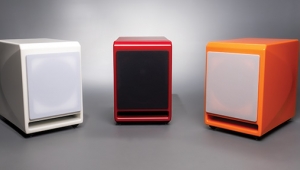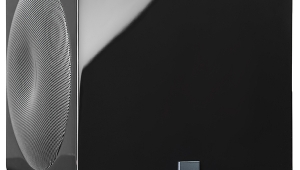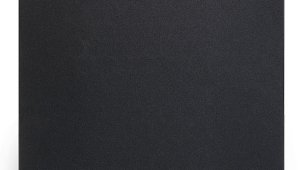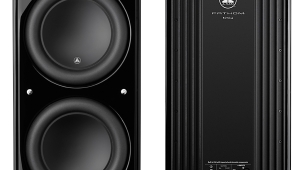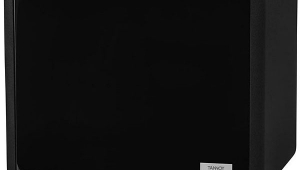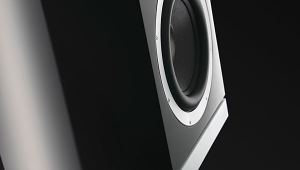| Columns Retired Columns & Blogs |
JL Audio Fathom f113 powered subwoofer Page 2
Matching levels: the Quads and the Fathom f113s
Installing two Fathom f113s in my system took a lot more time and careful listening than I'd anticipated. I had to adjust 10 controls on the Master f113, and 10 on the Bryston 10B-SUB electronic crossover. Once I'd listened to the two f113s in the dual-mono Master/Slave configuration, I repeated all setup steps with the two subs configured for stereo operation. For this I used two sets of tools: the signal generator, virtual spectrum analyzer, and microphone built into the Velodyne DD-18 sub; and JL Audio's own ARO system and mike. The Velodyne setup tools allowed me to match the f113s' output to those of the Quad ESL-989s. Though of course not part of JL Audio's installation package, the Velodyne system sure was helpful in completing the f113s' setup. (See my review of the Velodyne DD-18 in the June 2004 Stereophile, Vol.27 No.6, p.133.)
Installing two Fathom f113s in my system took a lot more time and careful listening than I'd anticipated. I had to adjust 10 controls on the Master f113, and 10 on the Bryston 10B-SUB electronic crossover. Once I'd listened to the two f113s in the dual-mono Master/Slave configuration, I repeated all setup steps with the two subs configured for stereo operation. For this I used two sets of tools: the signal generator, virtual spectrum analyzer, and microphone built into the Velodyne DD-18 sub; and JL Audio's own ARO system and mike. The Velodyne setup tools allowed me to match the f113s' output to those of the Quad ESL-989s. Though of course not part of JL Audio's installation package, the Velodyne system sure was helpful in completing the f113s' setup. (See my review of the Velodyne DD-18 in the June 2004 Stereophile, Vol.27 No.6, p.133.)
The Velodyne display system generates a sweep signal from 20 to 200Hz. Its own calibration mike captures the speakers' output and displays it on a video monitor. I placed the mike on the back of my listening chair at my seated ear height of 37" above the floor, and set the DD-18's volume control to "0" so that it would output no sound. I then keyed the Velodyne's remote to display its System Response screen on my TV monitor. This automatically triggered a repeated sweep tone from the DD-18's signal generator, which was fed by a long, single-ended interconnect to my Krell preamplifier.
The Quads, driven without the f113s, showed a dip at 60Hz and peaks at 70 and 40Hz, the response falling off 10dB by 35Hz (fig.1). I then ran the same sweep sequence on the pair of f113s alone, which revealed a peak at 50Hz (fig.2).

Fig.1 Quad ESL-989 frequency output, 20–200Hz, no subwoofer, in-room response (25dB vertical range).

Fig.2 JL Audio Fathom f113, uncorrected output, in-room response (25dB vertical range). Note 50Hz peak.
To match levels among the speakers, I first set the right, Master f113's level at 12 o'clock, and the left, Slave unit to Reference. This produced excessive levels of bass output. To correct this, I adjusted the Master sub's level control to 9 o'clock, which produced clean bass-drum strokes without overhang on "Cosmos . . . Old Friend," from the Sneakers soundtrack (CD, Columbia CK 53146). I found that the 0° setting of the Polarity control produced the tightest bass-drum note. I wrote down the switch positions, then turned to the ARO room-EQ procedure.
JL Audio's Automatic Room Optimization
JL Audio's ARO tests the room, then applies single-band equalization to tune out its most prominent deviation from a linear frequency response. JL's manual recommends that the user return all of the f113's controls to their factory default settings before starting ARO. I also shut off my dishwasher and air-conditioner, which produce very-low-frequency artifacts that can hoodwink ARO. I plugged the ARO calibration mike's cable into the Master f113's control panel, punched the Calibrate button, carried the mike to my listening chair, and held it up at ear level.
Within five seconds, the f113 had begun to play rapidly stepped test tones at high volumes. Just as quickly, it stopped and flashed a warning LED to signal that the sub's output was too low to perform the ARO routine. I made several adjustments of the level control, and the 4 o'clock setting proved successful. The stepped test tones were followed by slowly stepped low-frequency test tones and loud ascending sweeps that ran for another two minutes and made every loose object in the room vibrate. The f113's Calibrate light then stayed on continuously, indicating that ARO had been completed. A sweep with the Velodyne DD-18 revealed a smoother room response, with the 50Hz peak reduced (fig.3).

Fig.3 JL Audio Fathom f113 with ARO, in-room response (25dB vertical range). Note that 50Hz peak is flattened.
I unmuted the high-pass section of the Bryston 10B-SUB crossover, returned the Master f113's level control to its 9 o'clock position, and made final adjustments to the electronic crossover settings as I watched the Velodyne sweep signal on my TV. The flattest response for the Master/Slave configuration was achieved when the Bryston 10B-SUB's filter settings were 40Hz low-pass and 100Hz high-pass, the Fathom f113's Extended Low Frequency filter was set to –3dB, and its polarity set to 0° (fig. 4).

Fig.4 Quad ESL-989 output with two JL Audio Fathom f113s after running ARO, in-room response (25dB vertical range).
However, the sound was still not to my liking. In Master/Slave configuration, the f113s activated a powerful room mode when I played the sustained deep organ-pedal tones at the end of a recording of Herbert Howells' Master Tallis's Testament (CD, John Marks Records, advance sample). After consulting with JL Audio, I switched both subwoofers to Master, then set the Bryston crossover's bass output to Stereo and ran each f113 through its own separate ARO procedure. I then set their Extended Low Frequency filter controls to –6dB, to make their frequency-response curve, as displayed by the Velodyne DD-18, fall below 25Hz. Then I reset the Bryston crossover's filters to 40Hz low-pass and 70Hz high-pass.
Voilà! My system now had a more natural deep-bass response with no excitation of room modes, while the soundstage deepened and widened.
Music
Once level-matched and optimized to my room, the two Fathom f113s generated tight, deep, rock-solid bass. Nor did switching in the subs change the pitch, timbre, or quality of my Quad ESL-989s' midrange response. The resulting sound, even at high levels, was free of midbass honk, producing fast, clean, deep bass from recordings of percussion and orchestral music.
Besides the f113s' deep-bass response, what made the biggest impression on me was how two f113s deepened and widened the soundstage, greatly enhancing the Quads' imaging and portrayal of space. The Fathoms enabled the Quads to reveal instruments I hadn't heard before, such as the acoustic guitar that Emmylou Harris softly plays on the last track of Spyboy (CD, Eminent EM 25001-2): a show-stopping, over-the-top rendition of Daniel Lanois's "The Maker." The f113s increased the three-dimensionality of the soundstage, from back to front as well as from side to side. The massive, distorted bass notes on "Deeper Wells," also from Spyboy, had permeated the entire soundstage with other system setups. With the f113s those notes were still as powerful, but now were localized to the front and center of the stage, the drums and vocals behind them.
Other recordings benefited. The f113s added noticeable three-dimensionality to the Quads' reproduction of Barber's voice on Café Blue (CD, Premonition/Blue Note 21810 2), for example.
- Log in or register to post comments
